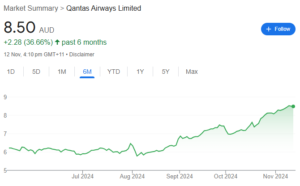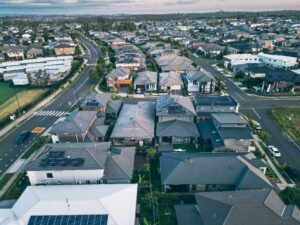Qantas Airways Shares: What’s Driving the Growth for FY25 and Have the Scandals of the Alan Joyce Era Been Left Behind?

Should you look at buying Qantas Airways Shares? Shares in Australia’s flag carrier finally surpassed pre-COVID highs in August 2024 and are up 62% in the last year. There’s no doubt that the airline has made significant efforts in rebuilding its brand after the controversies erupted during the Alan Joyce era. It is gradually renewing its fleet and rolling out customer service initiatives like improved app functionality and priority boarding. These may seem like trivial points, but altogether they aid the customer service experience and grant it advantages over its peers – just ask America’s United Airlines and how it has overtaken many of its peers for its initiatives.
And although Qantas could do with more long-haul aircraft, it has not been afraid to pivot its route network to capitalise on the most profitable routes and drop routes that are not working. Just look at its decision to can flights to Shanghai barely a year after re-starting them, due to intense competition with Chinese carriers. Conversely, it has done well with its direct flights between Perth and Paris and between Perth and Rome, not to mention routes like Melbourne to Dallas, Sydney to New York via Auckland and Sydney to Bengaluru. And of course, its frequent flyer scheme goes from strength to strength.
But what does the rest of FY25 hold?
Qantas Airways shares have finally bounced back post-COVID!
With the COVID-19 pandemic dampening the entire travel ecosystem, Qantas Airways was hit, but it made an impressive recovery from the steep drop. By resuming both domestic and international travel, the airline’s financial performance improved significantly in a short period.
It made a $1.7bn profit in FY23 followed by a $1.2bn profit in FY24. This underscored the swift comeback of the airline – not just travel demand generally, but the airline. Of course, it was not a completely smooth journey and in many ways this reflects why the share price has only surpassed pre-COVID highs in the past few months.

Growth drivers
A key criticism of Australia’s flag carrier was its conservatism on aircraft orders during the Alan Joyce era. Now it is making orders left right and centre. Its order book is headed with 12 Airbus A350-1000s, intended for long-haul flights, as part of its Project Sunrise initiative to offer direct flights from Australia to New York and London. These modern aircraft not only reduce emissions but also lower operating costs due to fuel efficiency, aligning with Qantas’ net-zero emissions by 2050 goal. If the Perth to Europe flights are any guide, these show people will pay a premium for non-stop long haul flights even if they are over 17 hours and even in economy. People may say one thing on social media, but will do another with their wallets.
But that order was 2 years ago. Earlier in 2024, Qantas ordered another 12 A350s, but the 900 model to replace the A330s and some A380 flying too, not to mention another 12 787s. Turning to its domestic fleet, Qantas will replace its 737s over the next decade with A220s and A321s. It has received the first 4 A220s, has another 25 firm orders for that type and will receive the first A321XLRs in CY25. And finally, it gradually replacing its regional Dash 8 Q200 and Q300 turboprops with second hand Q400s. Again, these will be more fuel efficient and have a higher capacity than the planes they replace.
Let’s briefly turn to Jetstar, a wholly owned subsidiary of Qantas. Jetstar’s fleet renewal is well underway with 18 A321LRs received and another 7 to come, not to mention 12 A321XLRs and 13 A320neos. These will allow longer flights with more passengers and more flights. Just look at how it has added more flights to Bali with A321s, freeing up its own 787s for other routes.
But now let’s turn to the popular Qantas Frequent Flyer program. It continues to be a key revenue driver for the airline, with over 14 million members – almost as many adults as they are in Australia! Although the days of the pandemic where it was the only division making money, it continues to contribute a substantial portion of Qantas’ profit. One initiative has been the introduction of ‘Classic Plus awards’ which are award seats that are variable in pricing (i.e. points required). This solves a common compliant of members, that they struggle to use their seats on points. Qantas Airways plans to further grow this program even further in FY25 by expanding partnerships, which should strengthen cash flow and customer loyalty.
From the Alan Joyce Era to the Vanessa Hudson Era
Alan Joyce, departed the airline after 15 years as CEO and over 20 years at the company. Now, we know he is a polarising figure but please hear us out here. There’s no doubt he achieved some good at the company. The airline is in a better position than it was 20 years ago when it had a more inefficient fleet, a frequent flyer program a shadow of what it was today and arguably overpaid staff. In many ways, the work he did from 2008 to 2019 ensured that the airline did not suffer the fate of Virgin Australia during the pandemic. He pioneer the alliance with Emirates, the idea of ultra-long haul flights from Perth to London that have evolved into the Project Sunrise Flights. Still, his tenure with Qantas was blemished by several high-profile scandals that impacted the brand’s and customer trust, starting with the 2011 fleet grounding.
During the pandemic, Qantas faced a lot of backlash for several things including its handling of flight cancellations and refunds, its selling of flights which it knew it was not going to operate and its outsourcing of 2000 ground handling jobs. Its operational issues post-pandemic were not entirely its fault, but were partially and the way they were handled added fuel to the fire. Call centres were overwhelmed, the company faced staff shortages with an inability to hire staff not to mention illnesses amongst the staff it had.
As well as this the chickens came home to roost on many decisions it had made during the pandemic. It was taken to court over the baggage handlers decision and lost. It was investigated by the ACCC over its handling of flight credits and selling of tickets on cancelled flights.
Amid these ongoing scandals, Alan Joyce’s compensation packages drew high criticism. During his final year as CEO, Joyce received millions in bonuses, given customer dissatisfaction and workforce reductions. His high-profile exit package, estimated at over $24 million, also raised a lot of eyebrows. The public then had less trust associated with corporate accountability and because of that, the brand name of Qantas was subjected to criticism. Some of his personal decisions added fuel to the fire such as his buying of a mansion in Mosman that he ultimately never moved into, his implicit blame of customers for problems at airports when he said passengers were ‘match fit’ (even if he was right that customers were contributing to delays by forgetting to take laptops out of their bags when going through security, he just shouldn’t have said it), the decision to get involved so heavily in the Voice to Parliament campaign and his selling of over 80% of his shares just 3 months before he was meant to stand down.
The Vanessa Hudson era
Joyce’s departure was first announced in mid-2023 and Vanessa Hudson (his long term CFO) was announced as his replacement. It was bought forward to September 2023. Hudson’s focus has been very keen on rebuilding customer trust and addressing the pertaining legacy issues from the Joyce era. She has pumped more than $200m into various customer initiatives (such as improving call centres and on board meals) and this has shown in the $500m profit drop from FY23 to FY24. Also, on-time performance has improved and she has sought to resolve the legal disputes with the ACCC. These steps showed an unwavering commitment of the airline, under Hudson to regain the trust of its customers.
What Should Investors Look Out For
Qantas’ growth outlook for FY25 looks promising because the company has been through a lot and yet it stands tall as a flagship Australian airline.
Investors focused on growth will likely find Qantas’ aircraft upgrades and international route expansions compelling. There is a rise in travel demand and Qantas Airways is in the right position with its expansion to meet this demand. This will drive its growth potential for FY25.
The scandals of the Alan Joyce era continue to present reputational and financial risks, especially with ongoing ACCC investigations. However, with Hudson revamping the operations of the airline and increasing the footprint of this player in the travel sector, it is still wise for investors to keep an eye on any developments that could impact Qantas’ finances or brand reputation.
The tremendous leadership shift under Vanessa Hudson represents a golden opportunity to improve customer and employee relations. If Hudson’s initiatives succeed, Qantas Airways could see a significant recovery in the public’s eye and brand loyalty, which would support long-term growth.
As Qantas Airways resumed its dividends, income-focused investors found a great deal of appeal in it. However, dividend stability will depend on how the airline sustains its profit growth. It also depends on the successful resolution of pending legal challenges against the airline.
But arguably most important will be ex-chairman Richard Goyder’s standing aside for John Mullen. Many journalists and analysts covering the company noted Goyder’s unwillingness to challenge Alan Joyce led to many of these problems. And maybe Mullen won’t just give Hudson a blank cheque to do as she pleases like Goyder did with Joyce.
Qantas Airways: Growth with Caution
Qantas Airways is finally above pre-COVID levels as it puts the Joyce era to one side. But where to next for the share price? In favour of growth are Qantas’ dominant position in the domestic travel market, continually high travel demand and the opportunities that will come with fleet renewal. The case against Qantas is the argument that you should ‘never buy an airline‘, intense industry competition in the international travel market and the costs of constant fleet renewal.
Long-story short, Qantas Airways offers significant growth potential in the next 3-5 years, but some risks remain from legacy scandals and upcoming capex. Those willing to accept some short-term volatility and uncertainty may find value in Qantas’ prospects.
What are the Best ASX Stocks to invest in right now?
Check our buy/sell tips

Blog Categories
Get Our Top 5 ASX Stocks for FY26
Recent Posts
Diversifying Portfolios with ASX Consumer Stocks: Opportunities and Risks
The ASX 200 has delivered significant volatility recently, and market participants observing the screens in 2025 understand the turbulence firsthand.…
Is Lendlease (ASX:LLC) out of the doldrums for good?
Lendlease (ASX:LLC) has for the past several years been the classic definition of a ‘value trap’. You think a good…
Here are the 2 most important stock market taxes that investors need to be aware on
As one of two certainties in life, investors need to be aware of stock market taxes. Investors may be liable…


